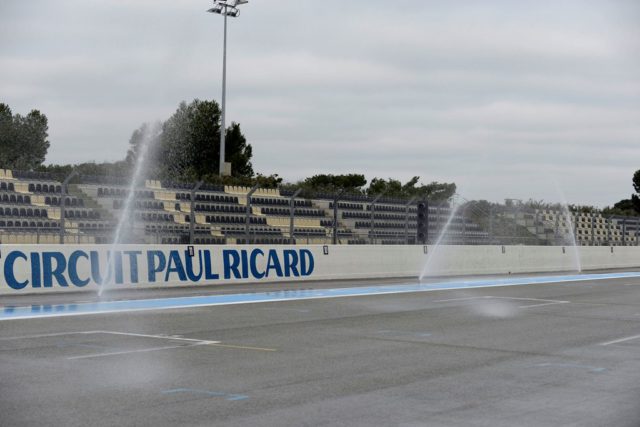The French Grand prix is the eighth round of the 2018 Formula 1 world championship.
Circuit Paul Ricard
Le Castellet
22-24 June 2018
Start time 16:10hrs local, 15:10hrs BST
Race laps 53
Tyre choice Yellow Soft, red Supersoft, purple Ultrasoft

Complete race distance: 309.626 kilometres (192.393 miles)
Pit lane speed limit: 80 kph (50 mph)
This 5.842-kilometer (3.63-mile), 15-turn circuit returns to Formula One in 2018 after a 28-year absence. Circuit Paul Ricard was home to the French Grand Prix from 1971 to 1990, where it hosted Formula One 14 times with countryman Alain Prost winning the last French Grand Prix at the track. Circuit Paul Ricard was built in 1969 thanks to the deep pockets of industrialist and pastis magnate Paul Ricard. It opened on April 19, 1970, with a two-litre sports car race before Formula One became the headliner a year later. The 1.8-kilometer (1.1-mile) Mistral Straight and the elongated track design is the signature of Circuit Paul Ricard. Built on a plateau, the track is very flat, but that doesn’t mean it’s boring. In fact, it’s a bit of a chameleon with 167 possible configurations ranging from a short .826-kilometer (.513-mile) course to the full, 5.842-kilometer (3.63-mile) layout used by Formula One.
The long circuit was used from 1971 to 1985, while the shorter club circuit was used from 1986 to 1990
With the departure of Formula One, the track transitioned to motorcycle and local racing. After Ricard’s death in 1997 at age 88, the track was sold in 1999 to Excelis, a company owned by former Formula One chief executive Bernie Ecclestone. The track was rebuilt into an advanced test facility, where it was renamed the Paul Ricard High Tech Test Track or Paul Ricard HTTT. It has since returned to its original name, Circuit Paul Ricard.
DYK? The colourful runoff areas at Circuit Paul Ricard aren’t just for show. The thick stripes of blue, black and red serve a practical purpose. The black and blue runoff areas feature a surface with a mix of asphalt and tungsten. A second, deeper runoff area coloured in red features a more abrasive surface designed to maximize tire grip and, subsequently, minimize braking distance. Altogether, it makes for an extremely practical layout instead of the traditional gravel used at most tracks. The innovation helped Paul Ricard Circuit become the first entity to be designated as a “Centre of Excellence” by the FIA.
During the course of the French Grand Prix, lows will range from 17-18 degrees Celsius (63-64 degrees Fahrenheit) to highs of 26-29 degrees Celsius (79-85 degrees Fahrenheit)
The average daily wind speed is around 16-18 kph (10-11 mph).
Toughest corner Turn 10, Signes. Arguably the most famous corner on the lap, this 85-degree right-hander is taken flat-out in eighth gear and requires 100 per cent commitment from the drivers. With an apex speed of 300km/h (186mph), it’s one of the fastest corners on the Formula 1 calendar.
Focus points Paul Ricard has recently been re-surfaced and the new asphalt is similar to Silverstone and the Circuit de Barcelona-Catalunya, where rear tyre temperatures were a concern during winter testing. To combat blistering, Pirelli has introduced a thinner tread on the tyres used at these tracks, the new-spec tyres being 1kg lighter than a conventional set.
Biggest challenge Aero balance. There are several long corners in the second half of the lap, notably Turns 11 and 12, through which a good aero balance is important. Ideally, the driver wants a benign car that’s easy to balance at high speed, while braking or accelerating and turning.

Braking Easy. Two weeks after the Canadian Grand Prix, which was one of the hardest tracks of the year on brakes, F1 goes to one of the least demanding tracks for braking. Paul Ricard has only four significant braking areas. There are three long straights along which to cool the brake systems.
Power The cars use 1.8kg of fuel per lap, which is just above average. The team expects no fuel consumption issues during the race.
Aero Medium downforce. The combination of three long straights and some medium-to-high speed corners forces the teams to reduce downforce levels. Not as low as Spa-Francorchamps or Monza, but it’s not a maximum downforce track.
It’s #FrenchGP ?? week !
10 years later, we’re back ?#GPFranceF1 #F1 pic.twitter.com/YwWuXFyKXh— Grand Prix de France F1 (@GPFranceF1) June 18, 2018

































